Images are the property of the Lebanon Historical Society and copyright laws may apply.
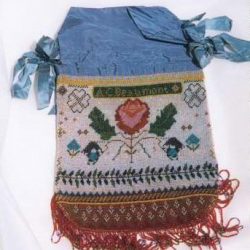
Beaded Reticule - 1837
Made by Abby Cornelia Beaumont
Silk drawstring purse or reticule with beaded decoration of flowers and leaves and the name
A.C. Beaumont.
A reticule, also known as a ridicule or indispensable, was a type of small handbag, similar to a modern evening bag, used mainly from 1795 to 1820. The reticule became popular in the late 18th century. A reticule usually had a drawstring closure at the top and was carried over the arm on a cord or chain. Reticules were made in a variety of styles and shapes and sometimes trimmed with embroidery or beading. Women often made their own reticules.
Abby Cornelia Beaumont was the eldest daughter of John and Abigail Beaumont and the niece of needlework instructor Ann Beaumont. Abby Cornelia’s sister Lucretia and several other girls named Ann Beaumont as “teacher” on their samplers.
Gift of Phyllis Bartizek
2001.002.00
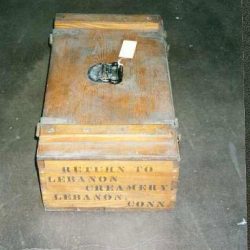
Butter Shipping Box – Circa 1900
Manufacturer unknown
Oak shipping box with dovetailed corners, sheet metal hinges and handle and cleats across the top. Ends are stenciled “Return to Lebanon Creamery / Lebanon CONN.”
The Lebanon Creamery opened in 1887 and remained an important part of Lebanon’s agricultural and business environment until its closing in 1933. One of the first commercial creameries in Connecticut, this enterprise stood just below a spring on Susquetonscut Brook (behind the present-day elementary school on Exeter Road). Having a reliable buyer nearby for their cream made it feasible for farmers to increase herd size for the first time, because profits could now be made from any surplus.
By the time a display of local butter garnered a gold medal at the 1893 World’s Columbian Exposition in Chicago, the Lebanon Creamery was reportedly the largest operation of its kind in the state. Packaged by hand, its freshly churned product shipped out of town in ice-cooled boxcars heading down the tracks to markets as far away as Providence, Boston and New York. Covered wagons, outfitted with large round collection cans, traveled from farm to farm to pick up the cream, which was also supplied by dairymen in Franklin and Columbia—towns then lacking their own creameries.
Gift of Judd Caplovich
1998.003.001
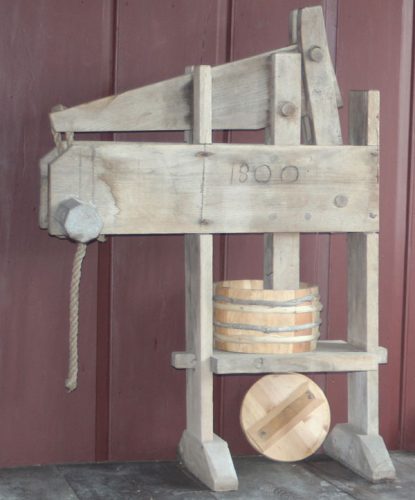
Cheese Press – Circa 1800
Maker unknown
Oak or chestnut frame with lever activated piston to apply pressure on the curds in the cheese hoop. Carved date is old and may record the construction of the device.
Press was found in the barn of the Whipple farm in Lebanon
Gift of Nellie Whipple
1981.098.002
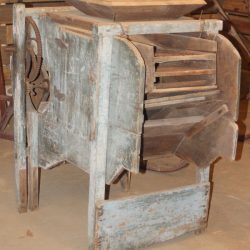
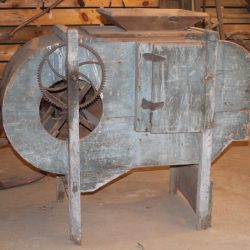
Fanning Mill
Circa 1830-1860
Maker unknown
Wooden case with a metal crank and wooden hand grip, and sliding drawers, rounded board edges, shaped carrying handles, and sometimes lathe-turned knobs atop the frame posts, appearing almost like a piece of furniture. This example retains much of its original blue paint.
Fanning mills removed straw, chaff, stones, dirt and dust, weed seeds, and light immature seeds from wheat, oats, rye, barley, and other grains. It was important to remove contaminants for better preservation during storage, to have mold and grit free flour, and for securing viable seed free of weed seeds that would compete with a growing cereal crop. Fanning mills were a great technical advance over winnowing, the hand-process of pouring grain from one container to another in a breeze to blow away the lighter matter.
The fanning mill has a history of use on the Hinckley farm in the Village Hill section of Lebanon but was probably not manufactured here.
Gift of Charles Hinckley
1993.001.003
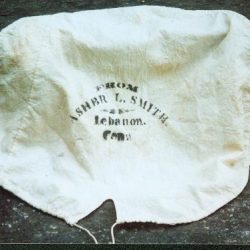
Fruit Basket Cover
Mid-19th Century
Maker unknown
An almost circular piece of white cotton with drawstring encased around the edge. Stenciled lettering in the center reads “Asher L. Smith Lebanon, Conn.”
In 1840, Asher Ladd Smith purchased Redwood from Jonathan George Washington Trumbull, youngest son of David Trumbull, for whom the house had been built between 1777 and 1780. Smith and his son Asher Pratt Smith began growing fruit commercially advertising that “Apples, Peaches and Strawberries will be furnished in their season; also Peaches and Tomatoes any time during the winter months, preserved perfectly fresh. The Pure Juice of the Grape ‘well refined,’ with no Alcohol added, for Medical and Church purposes will be offered according to the laws of the State.”
In 1856, Asher L. Smith published an homage to farming and the agricultural way of life titled How to get rich; or a key to honest wealth. Being a practical guide to business success. The 1860 census shows Asher P. Smith, farmer, as head of household, his wife Amera, and children Anna B. and Llewellyn P. Asher L. Smith (only 56 years old) still lived in the house with his wife, Wealthy, but called himself a “gentleman” not “farmer.” A servant and farm laborer also lived at Redwood.
The fruit-raising Smith family owned Redwood for just a century, leaving behind only a trace of their many farming enterprises. A few newspaper articles and advertisements, a label or two on boxes or jugs, and a fruit basket cover.
Lebanon Historical Society Collections
1999.000.283
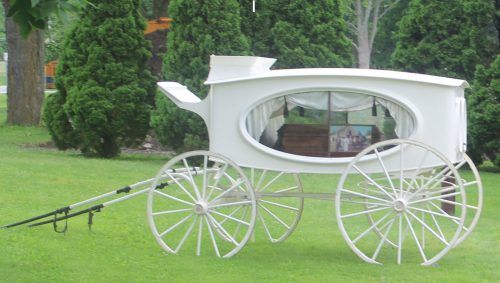
Hearse
Circa 1870-1880
Manufacturer unknown
During the third quarter of the 19th century, the Town of Lebanon purchased several hearses which were stored in hearse houses at three (or perhaps four) of the town’s cemeteries. The hearses were, apparently, available for residents’ use as needed. Over time all but one of the hearses disappeared and a group of citizens hid this last example in order to prevent its loss. After many years, at a town meeting, the town donated the single surviving hearse to the Lebanon Historical Society.
The hearse was restored by local craftsman Thomas Kozikowski who noticed that the original paint layer was white, perhaps suggesting that this hearse was used for children’s funerals. The upholstered interior is based on remnants found in other collections, the coffin is an exhibit prop and the photograph shows the group who “protected” the hearse for many years
Gift of the Town of Lebanon
1999.000.171
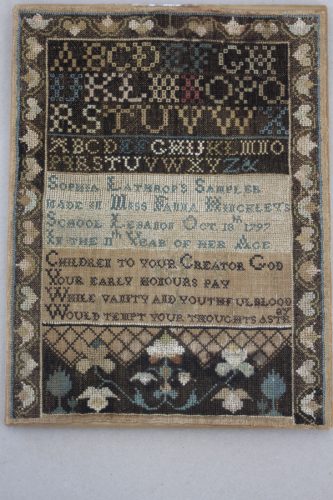
Sampler - 1797
Sophia Lathrop
Sophia Lathrop worked her sampler on a dark green linen background in three wide horizontal bands with letters and background stitching completely covering the ground. The center section reads “Sophia Lathrop’s Sampler / made in Miss Fanna Hinckley’s / School in Lebanon Oct. 18th 1797 / in the 11th year of her age. / Children to your creator God / Your early honours pay / While vanity and youthful blood / Would tempt your thoughts astray.” The top band includes two different alphabets and the bottom section has floral ornaments.
Fanna or Fanny Hinckley, the daughter of Charles and Elizabeth [Throop] Hinckley was baptized at Lebanon’s Goshen Congregational Church July 12, 1772. In 1802 she married Azel Fitch shortly before the family moved to Ashtabula, Ohio where she died in 1842.
Sophia Lathrop was the daughter of Charles Hinckley’s niece Lois Hinckley who married Uriah Lathrop December 30, 1784. Sophia was born in Bozrah, Connecticut June 19, 1787.
Lebanon Historical Society Museum Purchase
2005.003.001
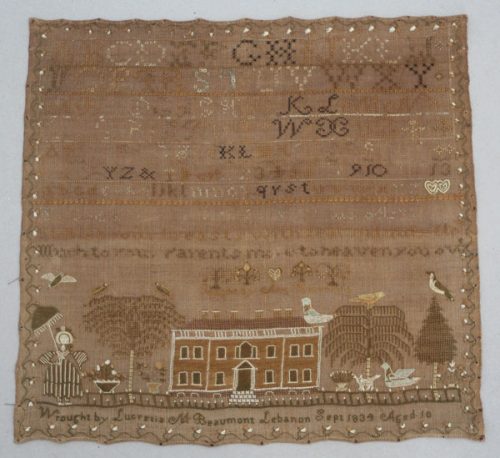
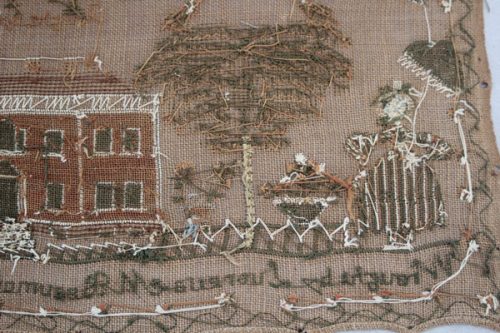
(reverse side)
Sampler - September 1834
Lucretia Beaumont
Lucretia Beaumont worked her sampler on a linen base with stitching in shades of green, gold, white, brown and black silk. The upper portion includes four different alphabets and numerals 1 through 13. The verse in the center reads in part:
…still let your breasts with zeal and duty…much to your more to heaven you owe”
The lower portion includes a large building with a Palladian window, and six chimneys, a girl with a parasol, several trees, three birds and two pots of flowers. “Taught by Ann Beaumont” is stitched above the building and below the scene “Wrought by Lucretia M Beaumont Lebanon Sept 1834 aged 10.”
Lucretia was the daughter of John and Abigail Beaumont. Her teacher Ann was her aunt, John’s older sister.
Both the identified teacher and details of the building, girl with parasol and birds relate this sampler to a group of eleven Lebanon girls and their samplers worked under instruction of Ann Beaumont and three other teachers.
Historical side note: John and Ann Beaumont grew up in the Beaumont House, which is now part of the Lebanon Historical Society.
Lebanon Historical Society Museum Purchase
1973.001.001
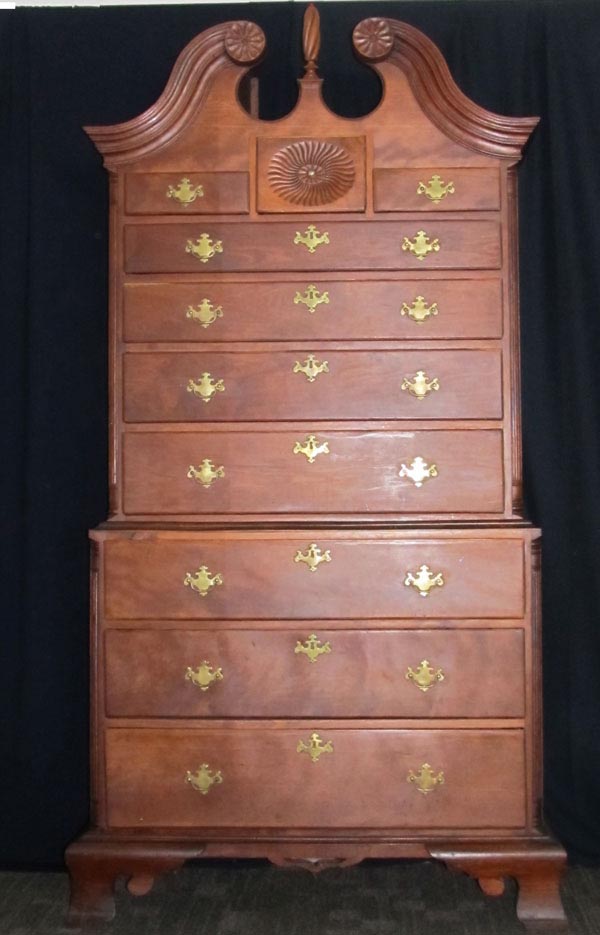
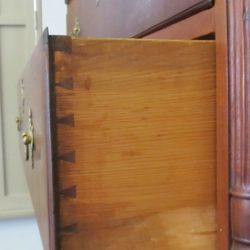
Newcomb Family Chest-on-Chest
Attributed to Peter Newcomb of Lebanon Crank
1760-1779
This chest-on-chest is one of a few Lebanon examples of early furniture in the Lebanon Historical Society collection. It is made of cherry and birch in a “high rural style” relating to furniture made in Colchester and Norwich. The secondary woods are chestnut, poplar and pine. It stands nearly 7 feet tall and 44 inches wide. While it has had damage to drawer edges, a replaced flame finial and finish, it is in excellent overall condition.
It was made sometime between 1760 and 1779, most probably by Peter Newcomb. At that time the Newcomb family home was near the intersection of the roads to Windham and Hartford, now Connecticut Routes 6 and 66. Peter was the second of three generations of Lebanon joiners [furniture makers]. He had inherited tools from his father and passed his own tools on to his son, William. Peter’s will, probated in 1779, gave this chest to his daughter Jemima. In an 18th century rural estate a good bed and its furnishings were usually the most valuable furniture. However, this chest was listed at 20% more than the best bed suggesting, perhaps, that it was an uncommon form in the community.
Jemima married Captain Gideon Clark of Lebanon in 1787 and this chest continued by
marriage through the Clark, Isham and Gillette families to the late 20th century.
2009
Lebanon Historical Society Museum purchase
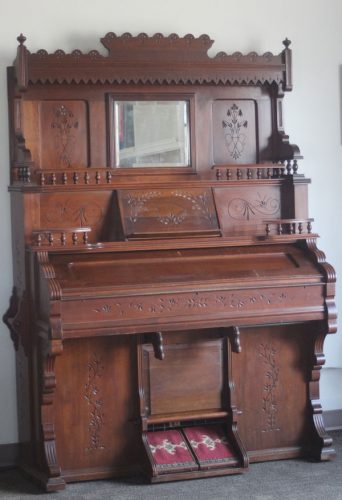
"Palace" Organ - Circa 1880
Made by Loring & Blake Organ Company, Worcester, Massachusetts
Large parlor-style pump organ that belonged to Lebanon resident Julia Manning Geer (born August 18, 1856 and died June 6, 1932). She was the daughter of Jabez Manning and Mary [Robinson] Manning and in 1874 married Joseph Manning. Her family recalls Julia having a piano as well as this organ.
Gift of Harold Geer and the Geer family
2006.022.001
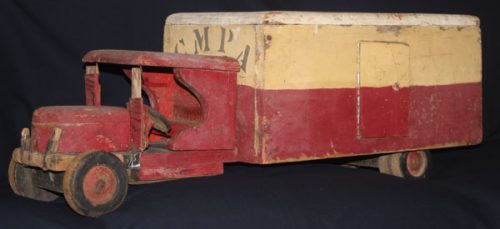
Toy Truck
Circa 1920-1950
Maker unknown
Replica of a milk truck owned by Pat Sullivan, who drove for the Connecticut Milk Producers Association (CMPA). The Sullivan business was located at 922 Trumbull Highway, which now, in 2018, is the Lebanon Animal Hospital. The CMPA trucks picked up 40-quart milk cans from dairy farmers, who took their cans to a platform at the edge of a road for collection. This toy truck was a Christmas present to the donor.
Based in Hartford, the Connecticut Milk Producers Association was a professional organization for the milk producers of Connecticut. It provided its members with a monthly newsletter and kept track of prices and production of milk within the state as well as in the neighboring states and was active between 1919 and 1947.
2003.076.001
Gift of John Walden
